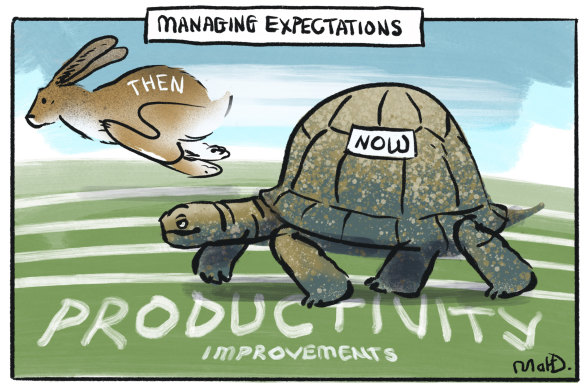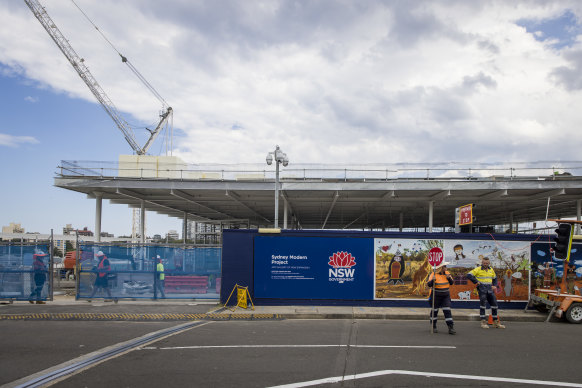Opinion
NSW Treasury kicks off the new realism: Productivity won’t be speeding up
Ross Gittins
Economics EditorHave you noticed how people keep banging on about “productivity” these days? That’s because it’s the secret sauce of economics, the bit that comes closest to giving us a free lunch. But also because we haven’t actually been getting much of it lately.
Unfortunately, that’s made productivity a happy hunting ground for bulldust propositions. So let’s spell out exactly what productivity is.

Credit:
A business – or a whole economy – improves its productivity when it finds ways to produce more outputs of goods and services with the same inputs of raw materials, labour and physical capital.
Sounds a great idea, but how is it possible? Short answer: advances in technology. Workers become more productive when they’re given tools and machines to work with. Many improvements in technology are designed to make workers more productive.
Better education and training make workers more productive by increasing their “human capital”. Even finding better ways to organise factories and offices can improve productivity. So can be teaching bosses better ways to jolly along their troops.
In my writing about the topic, I always focus on the simplest and least inaccurate way of measuring productivity. The productivity of labour is just output per worker or, better, output per hour worked.
Another approach would be to measure the productivity of the other main “factor of production”, capital equipment and constructions: output per unit of capital employed.
But economists often prefer to focus on “total-factor productivity” (or “multifactor productivity” as the statisticians prefer to call it): the growth in output (gross domestic product) that can’t be explained by increased use of labour and capital.
Economists have discovered that most of the improvement in people’s material standard of living over the years and centuries has come from improvement in total-factor productivity. This is why economists seem so obsessed by it. Keep productivity improving and we get wealthier.
But, as you see, total-factor productivity can’t be measured directly. It’s measured as a residual – what’s left when you take GDP and subtract two different things – which increases the chance your measurement is wrong.
And the truth is, economists don’t know as much about what causes productivity improvement as they ought to. That’s why they’ve spent the past decade debating the reasons that productivity growth has slowed significantly in all the advanced economies, not just Australia.
Theories abound, but there’s no agreement. And while we’re hearing plenty of tub-thumping sermons from business people (and central bankers) with their own axes to grind, there’s no agreement on what we should be doing apart from blaming the government and demanding it do something.
But last year, Professor Thomas Philippon of New York University wrote a working paper that offered a quite different explanation for the weak productivity growth we’ve been experiencing.
Conventional economic theory assumes that total-factor productivity grows “exponentially”, but Philippon has examined America’s productivity figures since 1947 – and done the same for a large group of other advanced economies – and found the growth has merely been “linear”.
Huh? Try this. If you have $100 growing 2 per cent each year, that’s exponential. If instead it just grows by $2 a year, that’s linear. Exponential growth is a fixed percentage rate; linear growth is a fixed absolute amount. The first $2 is 2 per cent of $100, but over the years the percentage rate of growth slowly declines.
So Philippon is saying we’ve been expecting productivity to grow at a much faster percentage rate than we should have been. Because its growth is “additive” rather than “multiplicative”, its annual percentage growth is declining.
The assumption that productivity improvement is exponential implies that innovation today makes further discoveries easier in the future. Philippon, however, finds that new ideas add to our stock of knowledge, but they don’t multiply it.
In the NSW Treasury’s new research paper, Trends in productivity: What should we expect, Keaton Jenner and Angus Wheeler have replicated Philippon’s exercise for Australia, getting similar results.

Economists often focus on total-factor productivity – the growth in gross domestic product that can’t be explained by increased use of labour and capital.Credit: Anna Kucera
Whereas the standard exponential model implies that total-factor productivity should have grown at the annual rate of 1.7 per cent between 1983 and 2019, they find this significantly overshoots actual productivity growth.
But the new, additive model implies that productivity increases by 0.024 points per year, with an annual growth rate that tapers down from 1.25 per cent in 1984 to 0.9 per cent in 2019.
So, Philippon’s additive model yields what would have been a much more accurate – though still slightly optimistic – forecast.
This suggests that, without some major new “general-purpose” technological advance (such as the spread of electricity, or the internal-combustion engine), the model predicts that total-factor productivity growth will slowly fall to zero per cent.
But this doesn’t mean living standards wouldn’t continue to improve. Because living standards are powered by the productivity of labour, the authors find, they would grow by increasingly larger absolute amounts, but not at a steady, exponential rate of growth.
In the NSW government’s intergenerational report in 2021, productivity projections were based on the historical 30-year average exponential rate of 1.2 per cent a year. Other assumptions meant that real gross state product was projected to grow at an average rate of 2.2 per cent a year out to 2041.
The authors repeat this exercise using an additive productivity model and find that annual growth in labour productivity declines from 1 per cent to 0.8 per cent over the 20 years to 2041. This means an average annual rate of growth in real gross state product of 1.9 per cent – 0.3 percentage points lower that projected in the 2021 report.
The authors point out that, if realised, the NSW economy would be about 7 percentage points smaller in 2041 than was projected in the report two years’ ago. This, in turn, would have “material implications” for the government’s revenue base and budget balance, assuming no offsetting reduction in government spending.
It will be interesting to see if Victoria and the other state governments recalibrate their projections using this new, more pessimistic – but more realistic – view of the future.
Ross Gittins is the economics editor.
Ross Gittins unpacks the economy in an exclusive subscriber-only newsletter every Tuesday evening. Sign up to receive it here.